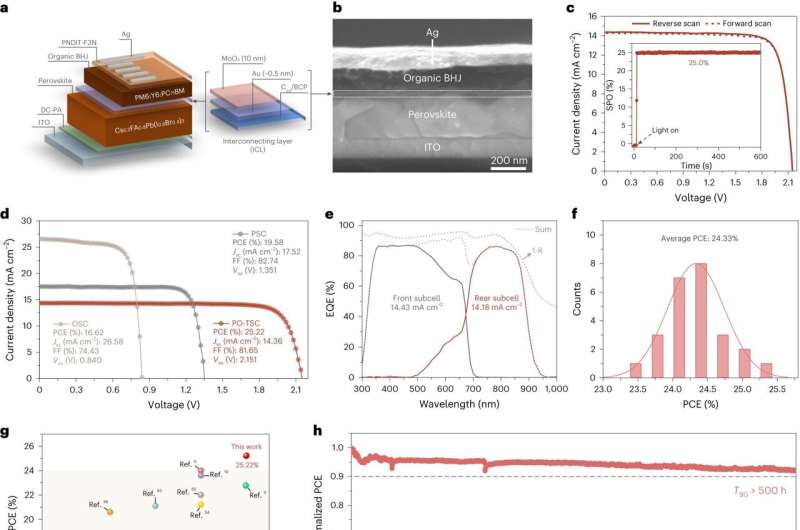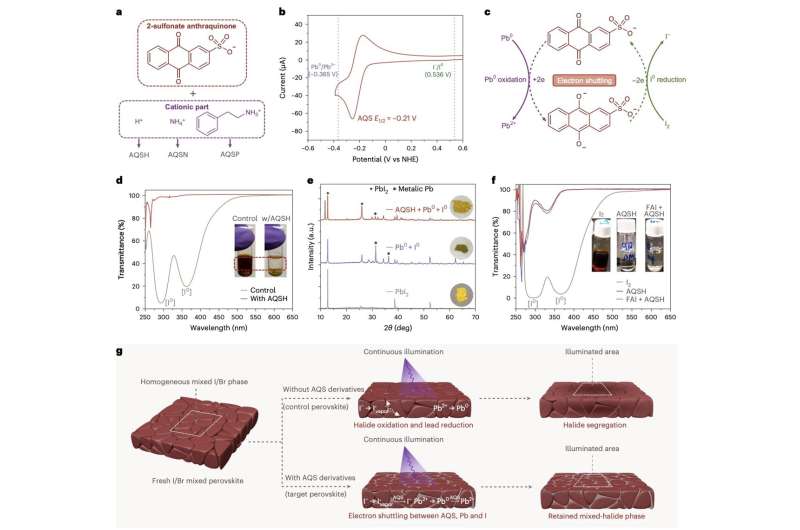February 28, 2024 feature
This article has been reviewed according to Science X's editorial process and policies. Editors have highlighted the following attributes while ensuring the content's credibility:
fact-checked
peer-reviewed publication
trusted source
proofread
Reducing halide segregation in wide-bandgap mixed-halide perovskite solar cells using redox mediators

Multi-junction solar cells, solar cells comprised of many individual semiconductor junctions stacked together, have the potential of outperforming single-junction solar cells both in terms of efficiency and stability. In recent years, material scientists and engineers have been trying to identify viable material combinations for fabricating these solar cells.
A class of materials found to be promising for these applications is metal halide perovskites, semiconductors with inherent properties that are advantageous for developing various optoelectronic devices and photovoltaics. While the efficiency of tandem solar cells based on these semiconductors has gradually improved and recently reached 24%, their stability is hindered by the severe phase segregation of mixed-halide perovskites.
Researchers at City University of Hong Kong recently set out to address this limitation of mixed-halide perovskite solar cells. Their paper, published in Nature Energy, introduces a strategy that could improve the long-term stability and photovoltage of these solar cells, utilizing newly designed redox mediators based on anthraquinone compounds.
"Halide segregation critically limits the stability of mixed-halide perovskite solar cells under device operational conditions," Shengfan Wu, Yichao Yan and their colleagues wrote in their paper. "There is a strong indication that halide oxidation is the primary driving force behind halide de-mixing. To alleviate this problem, we develop a series of multifunctional redox mediators based on anthraquinone that selectively reduce iodine and oxidize metallic Pb0, while simultaneously passivating defects through tailored cationic substitution."
The new anthraquinone-based redox mediators designed by Wu, Yan and their colleagues selectively reduce iodine while oxidizing metallic Pb0. Notably, the oxidation of halides with a relatively low oxidation potential ultimately enables the transport of halide mass, in turn leading to the phase segregation observed in perovskites.

The anthraquinone-derived redox mediators designed by the researchers, namely AQSH, AQSN and AQSP, can ultimately suppress halide segregation in perovskites. This can translate to a greater stability of solar cells based on mixed-halide perovskites.
To evaluate their proposed design strategy, the researchers used it to develop single-junction wide-bandgap perovskite solar cells. These cells were found to achieve a power-conversion efficiency of 19.58% and a high open-circuit voltage of 1.35 V for 1.81-eV PSCs, while also exhibiting enhanced stability.
"The device retains 95% of its initial efficiency after operating at its maximum power point for 500 h," wrote the researchers. "Most notably, by integrating the perovskite device into the monolithic perovskite-organic tandem solar cell as a wide-bandgap subcell, we report an efficiency of 25.22% (certified 24.27%) with impressive long-term operational stability (T90 > 500 h)."
The new redox mediator-based design strategy proposed by this team of researchers could soon help to enhance the performance of other mixed-halide perovskite organic tandem solar cells with varying compositions. This could ultimately facilitate the large-scale deployment of these solar cells, contributing to ongoing efforts aimed at decarbonizing electricity generation.
"Both the impressive efficiency and operational stability achieved by our tandem cells demonstrate the substantial potential of perovskite organic-tandem solar cells to outperform state-of-the-art perovskite-based tandem solar cells," the researchers concluded.
More information: Shengfan Wu et al, Redox mediator-stabilized wide-bandgap perovskites for monolithic perovskite-organic tandem solar cells, Nature Energy (2024). DOI: 10.1038/s41560-024-01451-8.
© 2024 Science X Network


















